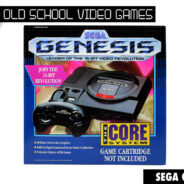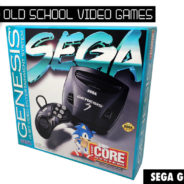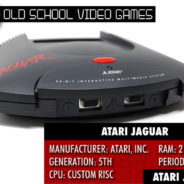Blog
Sega Genesis
History The Sega Genesis/Mega Drive Specifications Software Medium: Cartridge Microprocessor: RAM: RAM Expansion: Video Processor: Video RAM: Video Resolution: Color Depth: Video Outputs: Video Color Palette: Sprites: Audio: Audio Waveforms: Audio Outputs: Inputs: I/O: Standard Controllers: Alternate Controllers: Power Input: Games Library Number of Titles Worldwide: 897 Published by Sega: Published by 3rd parties: Incompatible titles: None Post-EOL Development?: Yes. New games are still being produced by homebrew developers. ...
read moreSega Genesis 3
History The Sega Genesis 3 Specifications Software Medium: Cartridge Microprocessor: RAM: RAM Expansion: Video Processor: Video RAM: Video Resolution: Color Depth: Video Outputs: Video Color Palette: Sprites: Audio: Audio Waveforms: Audio Outputs: Inputs: I/O: Standard Controllers: Alternate Controllers: Power Input: Games Library Number of Titles Worldwide: 897 Published by Sega: Published by 3rd parties: Incompatible titles: Virtua Racing, Psycho Pinball, Earth Defense, Gargoyles, 32X, Sega CD Post-EOL Development?: Yes. New games are still being produced by homebrew developers. ...
read moreAtari Jaguar
History The Atari Jaguar, the successor to the unreleased 32-bit Panther, is a fifth generation console which first hit the market in November of 1993 in North America. Most other markets, except Spain in 1995, received it in mid-to-late 1994, and official sales of the console ran until 1996. The Jaguar is a cartridge-based console with a later CD-ROM add-on, and an eventual library of around 50 games. The console sold less than 250,000 units in its lifetime, leaving Atari with a significant un-sold inventory. The Jaguar was touted as a 64-bit console due to its its custom Tom and Jerry chips both being 32-bit and, in Atari’s eyes, working as one sharing a 64-bit memory bus. There was much dispute over the accuracy of this claim, but the console was undoubtedly more advanced than most of its contemporaries in several ways. Tom encapsulated a GPU, Object processor, and Blitter. While Jerry behaved as a DSP, handling audio, I/O, and UARTs. Unfortunately, developing towards those strengths was difficult and many developers took shortcuts or simply ignored the advances in the interest of time-to-market or ease of porting. Designed for Atari by Flare Technology, who also worked on the unreleased Panther, the console is powered by a combination of Atari’s two custom RISC chips, Tom the GPU and Jerry the DSP, and a Motorola 68000 intended as a management chip. Much to Atari’s consternation, many developers simply developed towards the 68000 and avoided many of the features and performance of the advanced, but cumbersome to program for, dual-chip environment. This led to a plethora of games which did not show off Jaguar’s power and led some to believe it was less performant than Atari claimed. A few titles which took full advantage of the architecture, however, made it clear that there was more under the hood than just a 68000. Manufacturing of the console was arranged through a deal with IBM. The Jaguar was released in North America on November 23rd, 1993 at a US retail price of $249. A European release followed June 27, 1994, with releases in Australia, Germany, and Japan before the end of the year. Spain would not see the console officially released there until April 1995. As previously mentioned, the Jaguar sold fewer than 250,000 units during its market lifetime. A CD-ROM add-on was released in September of 1995 and, despite its lackluster sales, the Jaguar had several peripherals and add-ons available both from Atari and third party vendors. These included the Pro controller, Memory Track cartridge, Team Tap multi-player tap, Jag-Link for networked play, Catbox A/V peripheral, among others. A working VR headset was demo’d at the 1995 Winter CES, but never made it to market. Plans for a ‘duo’ console, integrating the CD-ROM, were also scrapped due to poor sales. Specifications Software Medium: Cartridge ROMs up to 6MB and CD-ROM Microprocessor: 32-bit custom RISC GPU (Tom) @ 26.59 MHz, 32-bit custom RISC DSP (Jerry) @ 26.59 MHz, Motorola 68000 @ 13.295 MHz RAM: 2 MB RAM Expansion: None (8MB total theoretical) Video Processor: 32-bt customer RISC GPU (Tom) Video RAM: 4K SRAM + shared DRAM Video Resolution: Standard resolutions, 480i (NTSC), 576i (PAL). Capable of 160 to 800 pixels per line. Color Depth: 24-bit Video Outputs: Internal RF modulator, composite, S-Video, RGB Video...
read moreColeco Telstar Alpha
In the vault. Coming soon… History The Coleco Telstar Alpha, released in 1977, was one of a long line of Pong machines produce by Coleco in 1976 and 1977. The Alpha featured four Pong variations: Tennis, Hockey (Soccer), Squash/Jai-Alai, and Handball. This all-in-one had two built-in analog paddles and an RF output cable. Power was derived from six C-cell batteries or an optional Coleco 6041 AC adapter. A difficulty setting switch affected both available players and allowed for Beginner, Intermediate, and Pro settings. Specifications Model: 6030 Software Medium: N/A Microprocessor: General Instrument AY-3-8500/AY-3-8500-1 ‘Ball & Paddle’ IC RAM: N/A RAM Expansion: N/A Video Processor: Direct RF out from AY-3-8500 Video RAM: N/A Video Resolution: 525 lines (NTSC), 625 lines (PAL) Color Depth: B&W Video Outputs: Internal RF modulator Video Color Palette: B&W Sprites: N/A Audio: Noise generator via AY-3-8500 Audio Waveforms: Noise Audio Outputs: Internal RF modulator Inputs: N/A I/O: N/A Standard Controllers: Two built-in analog potentiometers/paddles Alternate Controllers: N/A Power Input: 9v DC Games Library Built-In: Tennis, Hockey, Handball, Squash/Jai-Alai. These games are all Pong variants and the AY-3-8500 provided only Tennis (Pong), Soccer (used for Hockey) and Squash (used for Handball and Squash/Jai-Alai) variations. There were 3 unused games available from the AY-3-8500 chip: Practice, Rifle Game 1, Rifle Game 2. Additionally, a 7th hidden game, often called Handicap, was possible. This was aHockey variant which gave the right player an additional third...
read more




You must be logged in to post a comment.